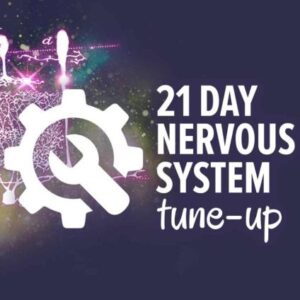This article delves into the concept of a 28 day somatic workout, exploring its potential benefits for nervous system regulation and overall well-being, drawing insights from programs like Naomi Fenn’s “21 Day Nervous System Tune-Up” to provide a comprehensive understanding.
28 Day Somatic Workout
The idea of a 28 day somatic workout encapsulates a focused period dedicated to consciously engaging with your body’s sensations and movements to promote healing and regulation within the nervous system. It’s about more than just physical exercise; it’s a commitment to deeply listening to your body and responding with intentional practices.
The Foundation: Somatic Awareness
Somatic awareness is the cornerstone of any effective 28 day somatic workout. It involves intentionally shifting your attention inward, noticing the subtle sensations, tensions, and emotions held within your body. This isn’t about judgment or trying to change anything, but rather about cultivating a deeper understanding of your internal landscape. The more attuned you become to these inner signals, the better equipped you are to address imbalances and promote self-regulation.
Think of it as tuning into your body’s radio station. For years, you might have been listening to external noise – the demands of work, the expectations of others, the constant stream of information. Somatic awareness is about turning down the external volume and tuning into the internal signals. It’s about feeling the grounding sensation of your feet on the floor, noticing the rhythm of your breath, and acknowledging the subtle shifts in your energy throughout the day. This practice alone can be profoundly transformative, offering a sense of presence and connection that many of us have lost touch with.
Starting a 28 day somatic workout focuses on your ability to connect. This connection allows you to understand which area of your body needs healing. It lets you take full responsibility and find healing process.
Structuring your 28 Day Somatic Workout
Designing your personalized 28-day somatic workout requires a mindful approach, integrating various techniques tailored to your specific needs and preferences. The aim should be to create a consistent and sustainable practice that fosters nervous system regulation and overall well-being. The structure might look something like this for example:
Week 1: Focus on grounding and establishing a baseline of awareness. Gentle movements, breathwork, and mindfulness practices are emphasized. Daily journaling to record sensations and observations is encouraged.
Week 2: Introduce gentle movement practices like yoga or tai chi, paying close attention to how each movement feels in the body. Explore different types of movement and notice which ones feel most beneficial. Continue with daily journaling.
Week 3: Begin to incorporate more targeted somatic exercises, such as those focused on releasing tension in specific areas of the body. Explore emotional release techniques, like gentle shaking or toning, if appropriate. Review journal entries and adjust the program as needed.
Week 4: Continue with the established routine, deepening the connection to the body and refining the practice. Focus on integrating the lessons learned during the previous weeks into daily life. Plan for maintaining the practice beyond the 28 days.
It’s crucial to remember that this is a journey of self-discovery, not a rigid program. The emphasis should always be on what feels right for your body. If a particular exercise causes discomfort or triggers a strong emotional reaction, it’s important to listen to that signal and adjust the practice accordingly. It’s also wise to consult with a qualified somatic practitioner or therapist to ensure that your program is safe and effective, especially if you have a history of trauma or chronic health conditions.
Integrating the “21 Day Nervous System Tune-Up” Principles
The principles outlined in programs like Naomi Fenn’s “21 Day Nervous System Tune-Up” provide a valuable framework for your 28 day somatic workout. The program underscores the importance of addressing the nervous system directly, recognizing it as the foundation for overall health and well-being.
Consider incorporating elements from the program, such as the educational videos focusing on survival stress and the audio exercises designed to unlock the body’s innate healing capacity. The program’s emphasis on blending neuroscience with sensory awareness and functional movement practices can enrich your somatic workout, offering both theoretical understanding and practical tools.
Furthermore, the program’s differentiation from other modalities is important to keep in mind. Many traditional approaches often overlook the crucial role of the nervous system, focusing instead on symptom management. By prioritizing nervous system regulation, your somatic workout can address the root causes of imbalance, leading to more lasting and profound healing. This isn’t about dismissing other approaches; rather, it’s about recognizing the nervous system as the foundation upon which other healing modalities can be most effective.
How Much Does It Cost For a Tune Up
Understanding how much does it cost for a tune up in the context of nervous system regulation and somatic practices requires looking at both the monetary investment and the investment of time and energy. It’s not simply about a price tag; it’s about the value of the potential transformation and healing it can bring.
Financial Costs: Exploring Options
The financial cost of a nervous system “tune-up” can vary greatly depending on the approach taken. There are options ranging from free self-guided practices to comprehensive, professionally-led programs.
Self-Guided Practices: Many basic somatic exercises, mindfulness techniques, and breathwork practices can be learned through free online resources, libraries, or community centers. While these options require no direct financial investment, they do demand a commitment of time and self-discipline.
Online Programs: Programs like the “21 Day Nervous System Tune-Up” typically have a set cost, which may range from a few hundred dollars to several thousand, depending on the depth and scope of the program. These programs often include video lessons, audio exercises, and support materials. One should consider the “how much does it cost for a tune up” to make sure you are getting the right deal,
Individual Therapy or Coaching: Working with a qualified somatic therapist or coach can provide personalized guidance and support, but it also comes with a higher price tag. The cost of individual sessions can vary depending on the therapist’s experience, location, and specialization.
Group Workshops and Retreats: These immersive experiences can offer a powerful way to deepen your understanding and practice of somatic techniques, but they also tend to be more expensive than online programs or individual sessions.
When evaluating the financial cost, it’s important to consider what you’re getting in return. Will the program provide you with lasting tools and skills? Does it offer ongoing support? Does it align with your individual needs and goals? Don’t hesitate to research different options, read reviews, and compare prices to find the best fit for your budget and objectives.
The Investment of Time and Energy
Beyond the financial aspect, it’s equally important to consider the investment of time and energy required for a nervous system tune-up. Building a regulated nervous system is not a quick fix; it requires consistent effort, dedication, and a willingness to be present with uncomfortable sensations and emotions.
Time Commitment: A successful nervous system tune-up demands a dedicated time commitment. Whether you’re following an online program or working with a therapist, you’ll need to set aside time each day or week for practice and integration. This might involve 15 minutes of daily breathwork, an hour of weekly somatic exercises, or a weekend workshop.
Emotional Energy: Healing trauma and regulating the nervous system can be emotionally demanding. It requires a willingness to confront difficult emotions, challenge limiting beliefs, and step outside of your comfort zone. This process can be challenging, but it’s also incredibly rewarding.
Mental Energy: Building a regulated nervous system requires a shift in mindset. It demands a commitment to self-compassion, patience, and non-judgment. It also requires a willingness to learn new concepts, experiment with different techniques, and adapt your approach as needed.
Before embarking on a nervous system tune-up, it’s important to realistically assess your available time, energy, and emotional resources. Are you willing to make the necessary sacrifices and prioritize your well-being? Are you prepared to face potential challenges and setbacks? If so, the investment of time and energy can yield profound and lasting rewards.
Is it Worth it? Weighing the Pros and Cons
Ultimately, the decision of whether or not a nervous system tune-up is “worth it” is a personal one. It depends on your individual needs, goals, and circumstances.
Potential Benefits: A regulated nervous system can lead to numerous benefits. It can help you reduce stress, improve sleep, enhance emotional regulation, strengthen your immune system, and foster deeper connections with yourself and others.
Potential Drawbacks: The process can be challenging, time-consuming, and emotionally demanding. It may also require a significant financial investment. There is no guarantee of specific outcomes, and individual results can vary.
Before making a decision, take the time to honestly assess your situation. Consider your current level of stress, your physical and emotional health, your relationships, and your overall sense of well-being. Weigh the potential benefits against the potential drawbacks, and listen to your intuition. If you feel a strong pull towards nervous system regulation, it may be a sign that it’s the right path for you.
Nervous System Healing Course
A nervous system healing course offers structured education and practices aimed at regulating the autonomic nervous system (ANS), often disrupted by trauma and chronic stress. These courses provide tools and knowledge to cultivate resilience and improve overall health.
Identifying the Right Course for Your Needs
Choosing the right nervous system healing course is essential for maximizing its potential benefits. The market offers a variety of courses, each with its unique approach, focus, and target audience. Therefore, careful consideration of your individual needs, preferences, and goals is crucial.
Assess Your Needs and Goals: Before diving into the world of nervous system healing courses, take some time to reflect on your specific needs and goals. Are you hoping to reduce anxiety, improve sleep, heal from trauma, enhance emotional regulation, or simply cultivate a greater sense of well-being? Understanding your primary objectives will help you narrow down your options and find a course that aligns with your aspirations.
Consider Your Learning Style: Different courses cater to different learning styles. Some courses are heavily focused on theory, while others emphasize hands-on practice. Some offer live sessions and group interactions, while others are self-paced and asynchronous. Consider your preferred learning style and choose a course that complements your strengths and preferences.
Evaluate the Instructor’s Credentials and Experience: The effectiveness of a nervous system healing course largely depends on the expertise and experience of the instructor. Look for instructors who have a strong background in neuroscience, somatic practices, trauma healing, or related fields. Check their credentials, read their biographies, and watch their introductory videos to get a sense of their teaching style and approach.
Read Reviews and Testimonials: Before enrolling in a nervous system healing course, take the time to read reviews and testimonials from past participants. These firsthand accounts can provide valuable insights into the course’s content, quality, and effectiveness. Pay attention to both positive and negative feedback, and use this information to make an informed decision.
Core Components of an Effective Course
While the specific content may vary, effective nervous system healing courses typically share several core components that contribute to their success. These components provide a comprehensive and well-rounded approach to nervous system regulation and trauma healing.
Education on the Nervous System: A solid understanding of the nervous system’s structure and function is crucial for effective regulation. A good course will provide clear and accessible explanations of the autonomic nervous system, the vagus nerve, the polyvagal theory, and the impact of trauma and stress on the nervous system.
Somatic Practices: Somatic practices are movement and awareness techniques that help you connect with your body, release tension, and regulate your nervous system. Effective courses will incorporate a variety of somatic practices, such as mindful movement, body scan meditations, grounding exercises, and emotional release techniques.
Breathwork Techniques: Breathwork is a powerful tool for regulating the nervous system and promoting relaxation. A quality course will teach you various breathwork techniques, such as diaphragmatic breathing, box breathing, and alternate nostril breathing, and guide you on how to incorporate them into your daily routine.
Trauma-Informed Approach: If you’re seeking a nervous system healing course to heal from trauma, it’s essential to choose one that is trauma-informed. This means that the course is designed to be sensitive to the needs of trauma survivors and avoids triggering or re-traumatizing experiences. A trauma-informed course will emphasize safety, empowerment, and self-regulation.
Community and Support: Healing from trauma and regulating the nervous system can be challenging, and having a supportive community can make a significant difference. Look for courses that offer opportunities for interaction with other participants, such as online forums, group coaching calls, or in-person retreats.
“21 Day Nervous System Tune-Up” as a Starting Point
Programs like Naomi Fenn’s “21 Day Nervous System Tune-Up” offer a valuable introduction to nervous system regulation and can serve as a foundation for further exploration. The program’s blend of neuroscience education, sensory awareness practices, and functional movement exercises provides a comprehensive starting point for individuals seeking to improve their well-being.
Accessible Introduction: The “21 Day Nervous System Tune-Up” is designed to be accessible to individuals with varying levels of experience with nervous system regulation. The program’s clear explanations, easy-to-follow exercises, and supportive materials make it an ideal starting point for beginners.
Practical Tools and Techniques: The program provides a range of practical tools and techniques that you can integrate into your daily life to regulate your nervous system and manage stress. These include audio exercises, educational videos, and integration lessons.
Framework for Deeper Exploration: While the “21 Day Nervous System Tune-Up” is a valuable resource in itself, it also serves as a stepping stone for deeper exploration of nervous system regulation and trauma healing. After completing the program, you may choose to pursue further education, work with a therapist, or explore other somatic practices.
The “21 Day Nervous System Tune-Up” cost is a good reflection of what is included in the program. You get a lot for a fair amount of money.
21 Day Nervous System Reset
The 21 day nervous system reset is a concept emphasizing a concentrated period dedicated to implementing practices and techniques designed to recalibrate and revitalize the autonomic nervous system (ANS). The goal is to shift the nervous system from a state of chronic stress and dysregulation towards a state of balance and resilience.
Benefits of a 21 day nervous system reset
Undertaking a 21 day nervous system reset offers potential benefits that extend across various aspects of life, fostering improved well-being and resilience.
Enhanced Emotional Regulation: A regulated nervous system is better equipped to handle stress and emotional challenges. The 21 day nervous system reset aims to cultivate a greater capacity to recognize, accept, and manage emotions without being overwhelmed by them. This can lead to more stable moods, improved relationships, and a decreased tendency to react impulsively.
Improved Sleep Quality: A dysregulated nervous system can interfere with sleep, leading to insomnia, restless sleep, and daytime fatigue. By calming the nervous system, the 21 day nervous system reset promotes relaxation and improves sleep quality. This can result in feeling more rested and energized throughout the day.
Strengthened Immune System: Chronic stress and nervous system dysregulation can weaken the immune system, making you more susceptible to illness. By reducing stress and promoting relaxation, the 21 day nervous system reset can strengthen the immune system and enhance your body’s ability to fight off infections.
Increased Energy Levels: When the nervous system is in a state of chronic stress, it consumes a significant amount of energy, leaving you feeling drained and fatigued. A regulated nervous system is more efficient at managing energy, resulting in increased vitality and stamina.
Improved Focus and Concentration: A dysregulated nervous system can interfere with cognitive function, leading to difficulty focusing, memory problems, and brain fog. By calming the nervous system, the 21 day nervous system reset can improve cognitive clarity and enhance your ability to focus and concentrate.
Reduced Physical Symptoms: Nervous system dysregulation can manifest in various physical symptoms, such as headaches, muscle tension, digestive problems, and chronic pain. By addressing the root cause of these symptoms, the 21 day nervous system reset can provide relief and improve overall physical well-being.
Key Elements of a Successful Reset
An effective 21 day nervous system reset requires implementing a range of practices and techniques that work synergistically to calm the nervous system and promote regulation.
Mindfulness and Meditation: Mindfulness practices involve paying attention to the present moment without judgment. Meditation techniques, such as breath awareness meditation or body scan meditation, can help calm the mind, reduce stress, and promote relaxation.
Breathwork Exercises: Specific breathing techniques can directly influence the autonomic nervous system, promoting relaxation and reducing stress. Diaphragmatic breathing, box breathing, and alternate nostril breathing are examples of breathwork exercises that can be incorporated into a 21 day nervous system reset.
Somatic Practices: Somatic practices involve connecting with your body through movement and awareness. These practices can help release tension, regulate emotions, and promote a sense of grounding and presence. Yoga, tai chi, and dance are examples of somatic practices that can be beneficial.
Nature Exposure: Spending time in nature has been shown to have a calming effect on the nervous system. Exposure to natural light, fresh air, and green spaces can reduce stress, improve mood, and enhance overall well-being.
Healthy Diet and Lifestyle: A healthy diet and lifestyle are essential for supporting nervous system function. Limiting processed foods, caffeine, and alcohol, while emphasizing whole, nutrient-rich foods, can help reduce inflammation and promote optimal nervous system health. Regular exercise, adequate sleep, and stress management techniques are also crucial.
Integrating “21 Day Nervous System Tune-Up”
The principles and practices outlined in programs like Naomi Fenn’s “21 Day Nervous System Tune-Up” provide a structured framework for implementing a personal 21 day nervous system reset.
Structured Approach: The “21 Day Nervous System Tune-Up” cost is a structured approach can provide guidance and support, ensuring that you are implementing effective practices and staying on track with your goals.
Educational Resources: The program’s educational videos and audio exercises can deepen your understanding of the nervous system and provide you with practical tools for regulation.
Customization: While the program provides a framework, it’s important to adapt the practices to your individual needs and preferences. Experiment with different techniques and find what works best for you.
Consistency: Consistency is key to success with any nervous system reset program. Make a commitment to practice regularly, even if it’s just for a few minutes each day.
Conclusion
In conclusion, engaging in a 28 day somatic workout or a 21 day nervous system reset, potentially informed by resources like Naomi Fenn’s program, offers a path toward profound well-being by focusing on nervous system regulation. These approaches, while varying in structure and intensity, share the common goal of enhancing awareness, promoting healing, and how much does it cost for a tune up of you. Whether through consistent somatic practices or a structured nervous system healing course, the journey towards a balanced and resilient nervous system is a worthwhile investment in overall health and thriving.
Sales Page:_https://21daytuneup.com/
Delivery time: 12 -24hrs after paid






Reviews
There are no reviews yet.